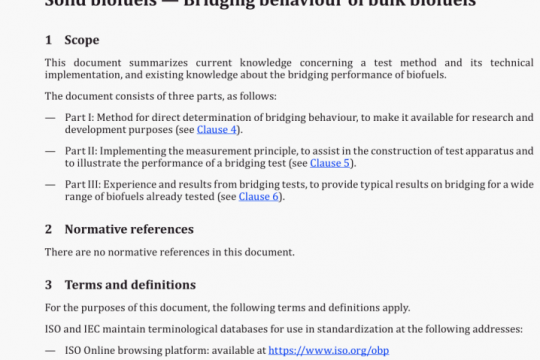ISO 2137 pdf free download
ISO 2137-2020 pdf free download.Petroleum products and lubricants – Determination of cone penetration of lubricating greases and petrolatum.
4 Principle
The cone penetration of lubricating grease is determined at 25 °C by releasing the cone assembly from the penetrometer and allowing the cone to drop for 5 s, and measuring the extent of the penetration. Three determinations shall be made and the average shall be reported as a result.
Unworked penetrations are determined on test portions transferred with a minimum of disturbance to a container suitable for test purposes.
Worked penetrations are determined immediately after working the test portion for 60 double strokes in a standard grease worker.
Prolonged worked penetrations are determined on test portions worked more than 60 double strokes.
Block penetrations are determined on a freshly prepared face of a cube cut from a block of grease with a standard cutter.
The cone penetration of petrolatum is determined by first melting and cooling a test sample under specified conditions and then measuring the penetration as for lubricating grease.
5 Classifications, procedures and limitation
The National Lubricating Grease Institute (NLGI) classifies greases according to their consistency, as measured by the 60 strokes worked penetration. The NLGI classification includes nine consistency numbers or grades, each grade corresponding to a given range of worked penetration. The NLGI classification is given in ISO 6743-99 and ISO 12924.
Clause 8 specifies four procedures for determining the consistency of lubricating greases by measuring the penetration of a full-scale cone. These procedures cover the measurement of unworked, worked. prolonged worked and block penetrations. Penetrations up to 500 units can be measured.
Clause 9 specifies methods for determining the consistency of lubricating greases when only small samples are available, by the use of cones a one-half-scale or one-quarter-scale of that used in Clause 8. The methods are applicable to greases having penetrations of 175 units to 385 units with the full-scale cone and are intended for use only if the size of the test sample prevents the use of cones described in Clause 8. They are not intended to replace the full-scale penetration as described in Clause 8. although a conversion to full-scale penetration is given in 1Q2. See 2.1 for the limitations on the use of one-quarter- scale cones due to the poor precision.
NOTE 1 Unworked penetrations do not generally represent the consistency of greases in use as effectively as do worked penetrations. The latter are usually preferred for inspecting lubricating greases.
NOTE 2 Penetration of block greases can be obtained on those products that are sufficiently hard to hold their shape. These greases generally have penetrations below 85 units.
Clause 10 specifies a method for the determination of the consistency of petrolatum by measurement of the penetration of a full-scale cone, having penetrations up to 300 units. This method can also be used to estimate the consistency of slack waxes.
6 Apparatus
6.1 Penetrometer, similar to that shown in Figure L capable of measuring, in tenths of a millimetre, the penetration of a cone In a test material.
EigurI shows a combined assembly; generally, it is allowed to displace vertically either the cone assembly or the plate.ISO 2137 pdf download.




